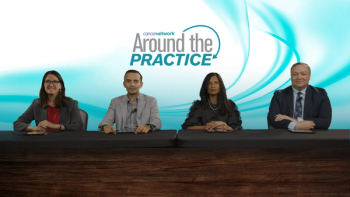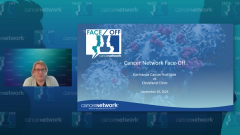
Cross Q&A: Role of Belantamab Mafodotin in MM
The panel discusses the efficacy of belantamab mafoditin and where the treatment fits in the multiple myeloma treatment landscape.
Episodes in this series

Transcript:
Jack Khouri, MD: Greg, you seem like a big fan of this.
Craig Cole, MD: What makes me kind of a fan is the patients I had on the trial, when we had to discontinue in November, I had patients who had to stop therapy and remained in very good, or even CRs [complete responses] for months and months. I think the longest one is a patient I still have from November when I discontinued, and she’s still in a CR. This is the longest she has gone in her entire myeloma life without receiving any therapy at all. So that I really like. And even though this study said that it didn’t bother patients at all, I was always kind of amazed at how my patients were willing to see 2 doctors and fill out forms in order to get their therapy. I still don’t know, if we quite know, all the dynamics of this drug. Because there was a stretch arm to some of the DREAMM trials where patients were getting it every 8 weeks and seemed to be doing perfectly well instead of every 3 weeks. And of course these long durations of patients not receiving anything, I think, are very interesting. So I’d really be interested to see how this moves forward.
Jack Khouri, MD: I agree. We’ve all had those patients, as you said, who actually would stop the drug and then still go. They’re still going with great responses so given now that we’ve had, 2 BCMA [B-cell maturation antigen]-targeted therapies already approved, with belamaf a star in the field of BCMA-targeted therapies. Where do you place this? Let’s say we have more data from DREAMM-7 [NCT04246047] and DREAMM-8 [NCT04484623]. Where do you think we’re going to place this drug in the landscape?
Craig Cole, MD: That’s a great question. I’ll tell you what keeps me up at night is, in Michigan, there’s the thumb of Michigan, where it is a kind of a desert of hematology. The hospitals there can’t afford the device-specific antibodies so we have patients driving hours and hours. We have patients who can’t travel to get CAR T [chimeric antigen receptor T-cell therapy]. So I think if we have patients that we want to target within these really distant areas, I can guarantee you that there’s an eye doctor in the thumb of Michigan. But there isn’t a transplant center up there or hospitals that can afford these really expensive therapies. I think that’s where this could fit, with the older patient who can’t travel long distances or any patient who can’t travel long distances, or in areas that aren’t as financially healthy. Some of those areas are in our own backyards. I mean, they’re patients who can’t afford these really top therapies that this would be a good option for.
Jack Khouri, MD: That’s fair.
Moaath Mustafa Ali, MD, MPH: Thank you, Dr Cole, for your nice presentation. I just want to make a really quick comment on the progression-free survival [PFS] as you can see from here and from the figure, the median PFS was 11.2 compared to 7.2. However, the hazard ratio was 1. This is a classic example, where the hazard ratio should not be used. The reason why is that when survival curves cross over the hazard ratio, rules are violated. Sarah Cox, who designed this statistical method, had an assumption that the proportional hazards should be constant and should not change, and once there’s a crossing over of survival curves, the hazard ratio is violated and that, unfortunately, can misguide a decision. As you can see, this is very clear-cut that the median PFS is inconsistent with the hazard ratio.
Jack Khouri, MD: This is where a degree in MPH can help you. Right, Mo?
Charles Schiffer, MD: Yes, that’s correct. But it’s also probably not true in that the median can really exaggerate differences or occasionally miss differences, and I think that the median is the number that gets focused on all the time because they think we’re not smart enough to be able to explain more than 1 end point to a patient. I mean a properly done hazard ratio is probably the most important way of determining the difference between 2 therapies. But you’re also right in that the sort of morphology of a curve can be important, for example, if you have a rapidly fatal disease and lose 20% or 30% of your patients very, very quickly, solid tumors all the time with both therapies and then have a therapy that works for some patients. You sort of have a concavity where you have a difference between your experimental group and your control group. The hazard ratio can be somewhat misleading there, but I think, if you look at those curves, they’re the same. I mean, there’s no difference whatever; the numbers show they don’t pass the eye test.
Moaath Mustafa Ali, MD, MPH: Yes, the issue and most important thing is really to look to the Kaplan-Meier and see how it looks. Sometimes the overall survival shows toward the big at the end and median survival there will not detect it. So then you’ll probably have to check for a PFS at a certain time, let’s say, 5-year overall survival or 5-year progression-free survival compared to the median survival. So it’s really not just 1 number that you have to look at [but] the whole figure, and examine it carefully.
Charles Schiffer, MD: I certainly agree. But in this case, when you look at those curves they look very, very similar overall.
Jeffrey Zonder, MD: At the time this study was released, these results were released. I found them to be a little disappointing. This drug—and again, this was in the moment the study results were being released—was basically withdrawn from the market because it only performed as well as another drug that was already approved in the same space. You would think that that actually might be enough to keep a drug on the market. You know, it was a useful, novel target, and as others have cited, we all had patients who benefited. But that said, it’s a hard drug to use. The eye management is real, and when the eye stuff is bad, it’s bad. In reality, all that said, that moment is gone, I mean, the field has moved on. And now we have BCMA-targeting therapies with literally twice the response rate. So patients may not be excited about travel for therapies, but they get more excited when you tell them it’s twice as likely to induce a response than what they could get in their backyard.
I do think there would be a very, very limited role for these particular agents in the current landscape, with much better BCMA-targeted agents available for both bispecifics and CAR Ts.
Craig Cole, MD: But you know the field is going to evolve because you remember when [daratumumab] first came out, it was something people traveled miles and hours for to go into the hospital for 2 nights and blah blah blah….Now we just give it as an injection and people walk away. And our advice on bispecifics is going to evolve like that super quick, which is going to be kind of a hard fit for this drug because were constantly evolving toward better and easier therapies.
Transcript is AI-generated and edited for clarity and readability.
Newsletter
Stay up to date on recent advances in the multidisciplinary approach to cancer.


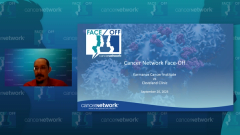

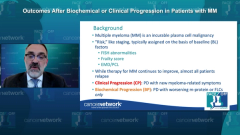

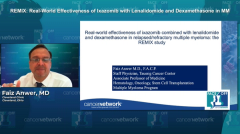
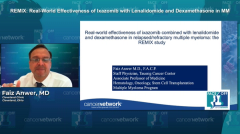
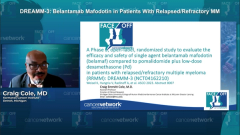

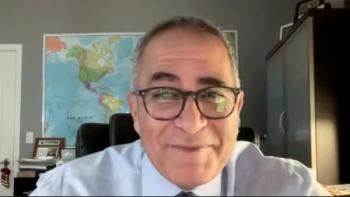
![“[This approval] will be a quite dramatic change in our philosophy and practice in multiple myeloma," according to Joseph Mikhael, MD, MEd, FRCPC, FACP, FASCO.](https://cdn.sanity.io/images/0vv8moc6/cancernetwork/3cab3ada4c023b68c118240a512e31d72a7f931b-1200x628.png?w=350&fit=crop&auto=format)
